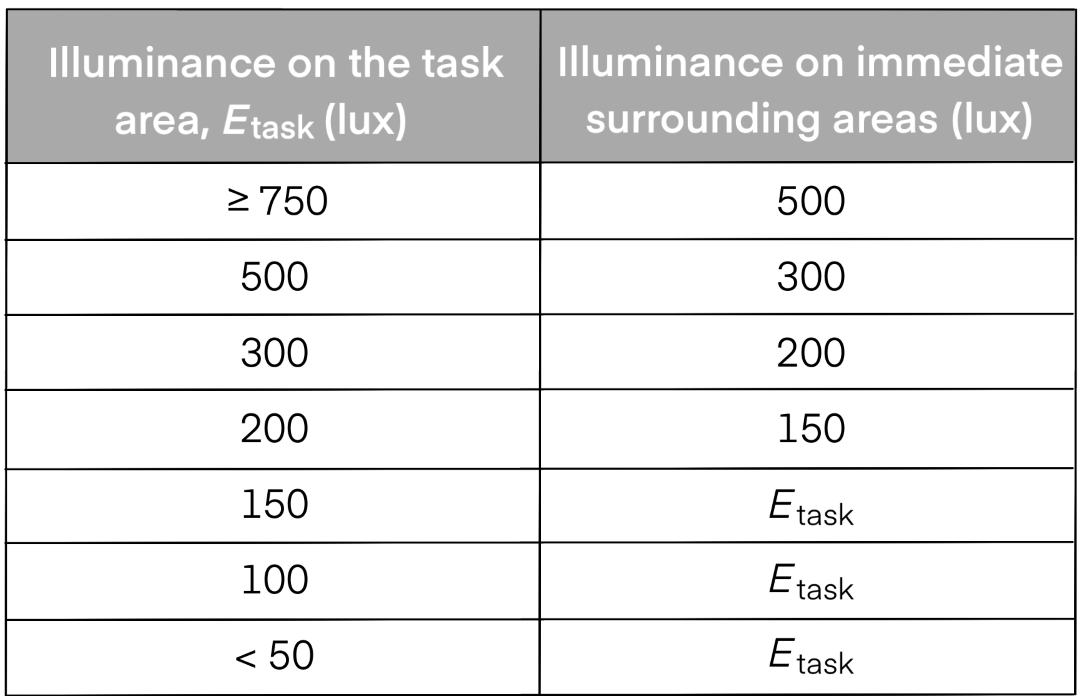Indoor workplaces.
Based on section 5 and annex B of the BS EN 12464-1: 2021: Light and lighting, this chapter offers lighting recommendations on how best to apply the standard whilst following what SLL regards to be good lighting practice.
Perceived brightness
The perceived brightness is a result of the interaction between illumination and the reflectance properties of objects and room surfaces. It’s important for the occupant’s wellbeing and alertness. In most cases, no detailed information is available on interior finishes, occupants seating and primary viewing directions, so illuminances are easier to evaluate than the luminance.
It is essential for good lighting design to follow the required illuminances (recommended lighting levels), as well as additional quantitative and qualitative parameters. To create a well balanced luminance distribution the luminances of all surfaces must be taken into consideration.
Reflectance of surfaces:
Recommended reflectance for the major interior surfaces are:
Ceiling: 0.7 to 0.9
Walls: 0.5 to 0.8
Floor: 0.2 to 0.6
Illuminance on the task area
The illuminance on the task area and on the surrounding area have a great impact on how quickly, safely and comfortably a person carries out a visual task.
The values specified in the BS EN 12464-1:2021 are maintained illuminances on a surface which can be horizontal, vertical or inclined. These are often referred to as CIBSE lighting levels in the workplace.
The values may be adjusted by at least one step in the scale of illuminances ( referenced to BS EN 12464-12021).
The illuminance should be increased when:
-
Visual work is critical
-
Errors are too costly to rectify
-
Accuracy, higher productivity or increased concentration is of great importance
-
Task details are of unusually small size or low contrast
-
The task area or activity area has a low daylight provision
-
The visual capacity of the worker is below normal
For a workstation where the size and location of the task areas are unknown, either treat the whole area the task area or light the whole area uniformly to an illuminance level specified by the designer.
Illuminance of the immediate surrounding area
The illuminance of the immediate surrounding area must be related to the illuminance of the task area. The immediate surrounding area should be a band with a width of at least 0.5m around the task area. The illuminance of the immediate area may be lower than the illuminance on the task area, in accordance with the table below.

Illuminance on the background area
In indoor workplaces, a large area outside the immediate surrounding area needs to be illuminated. It should be a border of at least 3 m wide adjacent to the immediate surrounding area and should be illuminated with a ⅓ of the value of the immediate surrounding areas.
It is wasteful to illuminate all areas to the same level and non-uniform lighting should be provided by local or localised lighting systems.

Learn more with our Workplace Lighting Design CPD.
A comprehensive guide to workplace lighting design packaged neatly into a one hour slot? Sounds too good to be true, but it's not. Our Workplace Lighting Design CPD is accredited by CIBSE and The CPD Accreditation Service, and includes everything you need to know about the subject.

